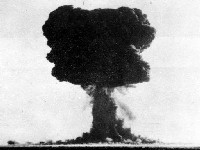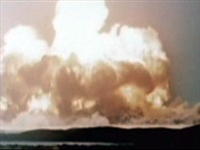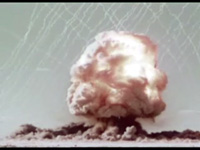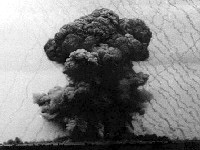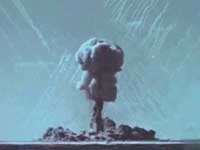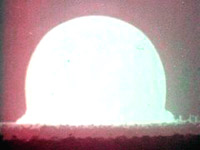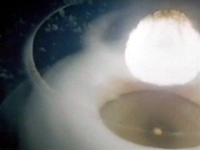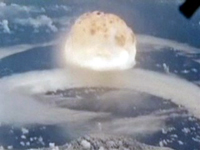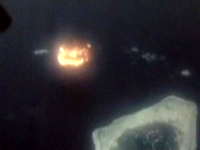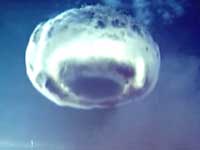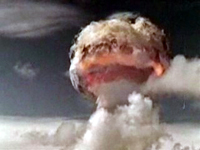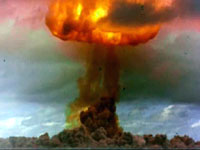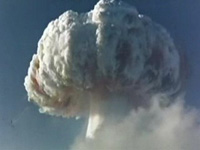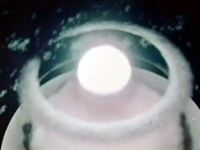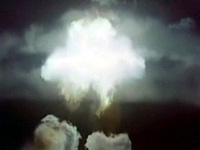 |
United Kingdom Archive
|
Hurricane
|
Date: 00:59 UTC 03/10/1952
Type: Seasurface @-3m
Yield: 25 Kt
The first British nuclear test, Hurricane was detonated in a lagoon on Trimouille
Island. The bomb was exploded inside the frigate HMS Plym which was anchored in 12
m of water. The device was a plutonium implosion bomb similar to the Fat Man using
plutonium produced at Windscale (now Sellafield).The test was devised to
investigate the effects of a ship-smuggled bomb. The ship was mostly vaporized by
the explosion, except for pieces of hot metal that set fires to the spinifex scrub covering
Trimouille. The explosion left a crater on the seabed 6m deep and 304m wide.The cloud rose only to
4572m due to the very dry air which allowed evaporation of water to cool the ascending cloud, and
a strong inversion at that altitude. Second clip courtesy of the fine upstanding ladies and gentlemen of the Imperial War Museum Archives.
View 2 |
News Reel |
Core Assembly
| |
|
Totem T1
|
Date: 21:30 UTC 14/10/1953
Type: Tower @31m
Yield: 9.1 Kt
Totem T1 was the first shot of operation Totem and the second ever British test shot. The series
was intended to develop greater knowledge after the initial test (Hurricane) which was rushed and
poorly instrumented. Plutonium with a much higher Pu-240 content (and thus lower cost) was now
being produced by the Calder Hall power reactors and needed to be evaluated. The explosion was
more powerful than expected with fallout badly contaminating the areas of Wallatinna and Welbourn
Hill. The cloud reached an altitude of 3000m.
| |
|
Mosaic G2
|
Date: 02:14 UTC 19/06/1956
Type: Tower @30m
Yield: 98 Kt
Mosaic G2 was a test of fusion-boosted weapon system, probably similar to the
Soviet Sloika and U.S. Alarm Clock designs. It incorporated lithium-6 deuteride,
an had a uranium tamper. It was the highest yield test ever conducted in
Australia. The test yield broke assurances made personally to the Australian PM,
that the yield would not exceed 2.5 time that of Hurricane, the fact that it did so
was kept secret until 1984.
|
|
|
Buffalo R1/One Tree
|
Date: 07:30 UTC 27/09/1956
Type: Tower @30m
Yield: 15 Kt
Round one was the first and largest of three test shots conducted at the One Tree site during
operation Buffalo. A test of the Red Beard tactical bomb, the cloud to reach a height of 11,430 meters. Even though meteorological
conditions were unfavorable, the shot was not postponed causing
much greater fallout than expected. One noteworthy feature of the first two Buffalo
explosions was the assembling of an 'Indoctrinee Force' designed to give British Commonwealth
military personnel the opportunity to gain operational experience of the effects of
nuclear weapons. Video courtesy of the Imperial War Museum Archives.
|
|
|
Buffalo R2/Marcoo
|
Date: 07:00 UTC 04/10/1956
Type: Surface @2m
Yield: 1.5 Kt
The second Buffalo shot was fired at the Marcoo site. It was a test of a low-yield Mark I enriched uranium device for the Blue Danube
bomb. The device was detonated on the surface to collect ground shock and cratering data. The explosion produced a crater 160 feet
wide, 40 feet deep and a 58 inch lip. Unexpected rain showers occurred after the explosion and as a result accurate fallout data could
not be obtained.
|
|
|
Buffalo R3/Kite
|
Date: 05:57 UTC 11/10/1956
Type: Airdrop @150m
Yield: 3 Kt
Round Three Kite was the UK's first air drop test of the Blue Danube bomb,
dropped from an RAF Valiant B1 bomber. This test was originally scheduled to use a service issue 40 kt core, but plans were changed due
to concerns about contamination if the airburst fuze failed and a surface explosion resulted. A low yield bomb core was substituted.
This shot was fired at the Maralinga Kite
site.
View 2
| |
|
Buffalo R4/Breakaway
|
Date: 14:35 UTC 22/10/1956
Type: Tower @30m
Yield: 10 Kt
This was the last test of Operation Buffalo, detonated at the Breakaway site. It was a test of the Red Beard tactical bomb. Some fusion fuel was included in the device as a physics experiment to supplement data collected during Operation Mosaic.
| |
|
Short Granite |Grapple|
|
Date: 19:37 UTC 15/05/1957
Type: Air drop @2400 m
Yield: 300 Kt
Short Granite was dropped by a Valiant B1 bomber piloted by Wing Commander K. Hubbard. Detonated after 52 sec of free fall. This was
Britain's first test of a radiation implosion thermonuclear bomb design. The device, named Green Granite Small, weighed 10,000 lb and
used a modified Red Beard primary (called "Tom") and a lead-encased lithium deuteride secondary (called "Dick"). Most of the yield was from
the secondary, providing evidence of successful radiation implosion, but the yield was far below the predicted value (about 1 megaton
was expected).
View 2
| |
|
Orange Herald |Grapple|
|
Date: 19:41 UTC 31/05/1957
Type: Air drop @2300m
Yield: 720 Kt
The Grapple tests served to demonstrate Britains ability to produce an h-bomb. The
government had a contingency plan that in the event that the tests were not fully
successful, a massive a-bomb would be used and passed off as an h-bomb. This
deception was concealed from the world, and even the drop crew. Orange Herald was this insurance policy, and after the disappointing
Short Granite, its detonation was "heralded" as proof of Britain's ability to produce an h-bomb. The crew were required to deliver the
bomb with extreme accuracy while flying with instruments only, as the windows were shuttered. While executing their escape, the
aircraft stalled and the acceleometer, a device essential to this manoeuvre failed and the aircraft was nearly incinerated.
Early Fireball
| Wide view and cloud development
|
|
|
Purple Granite |Grapple|
|
Date: 19:40 UTC 19/06/1957
Type: Air drop @2300m
Yield: 200 Kt
Purple Granite was the third and final test of the Grapple series also failed to produce
anywhere near the required yield. The scientists assured the government that if they were able to re-evaluate the data and redesign the
weapon, that another test series ahead of an
impending test-ban, would enable them to produce the required results. The "stop-gap" Orange Herald device was rushed into service with
the RAF in 1958 to be delivered by the V-bomber force.
|
|
|
Grapple X
|
Date: 17:47 UTC 08/11/1957
Type: Air drop @2250m
Yield: 1.8 Mt
Grapple X was Britain's first truly successful thermonuclear bomb test in that the
design yield was successfully reached. This was Britain's first megaton-class
explosion, showing that the UK had achieved mastery of H-bomb design. The test was
to be detonated over the uninhabited far end of Christmas Island to save money and
time. The island was a coral atoll atop an extinct volcano, and some of the
servicemen feared that the explosion would cause the Island to tip up and sink into
the sea.
|
|
|
Grapple Y
|
Date: 18:00 UTC 28/04/1958
Type: Air drop @2350 m
Yield: 3 Mt
Grapple Y was the second successful test of the new improved design which achieved a huge three megaton yield.
View 2
|
|
|
Pennant |Grapple Z|
|
Date: 18:00 UTC 22/08/1958
Type: Baloon @450m
Yield: 24 Kt
The first shot of Grapple Z, codenamed Pendant. Rather than being dropped by an aircraft, the bomb was suspended from a string of four vertically-stacked barrage balloons. Pendant had a 24 kiloton yield and used solid fusion boosting with lithium deuteride.
|
|
|
Flagpole |Grapple Z|
|
Date: 17:24 UTC 02/09/1958
Type: Air drop @2850m
Yield: 1 Mt
Flagpole was dropped on the morning of September 2 from a Valiant piloted by Bill
Bailey and exploded at an altitude of 2850m, it missed the target by 86m. The
maximum diameter of the fireball was measured as being 2590m. Three Canberra
aircraft flew cloud sampling missions, one of these spending over 11 minutes in the
radioactive cloud. The crew received radioactive doses of 100
milliSieverts.
|
|
|
Halliard 1 |Grapple Z|
|
Date:17:49 UTC 11/09/1958
Type: Air drop @2650 m
Yield: 800 Kt
The main objective of operation Grapple had been achieved and the US were once
again exchanging nuclear weapon design data with the UK. This meant that the
testing of Halliard 3 was no longer required, the device was converted into
Halliard 1 and was the last airdropped atmospheric test by the United Kingdom.
|
|
|
Burgee2 |Grapple Z|
|
Date: 18:00 UTC 23/09/1958
Type: Baloon @450 m
Yield: 25 Kt
The device was hoisted to altitude by four baloons, was the last ever UK atmospheric test and signified the end of operation Grapple.
|
|
|
|
|
 |





